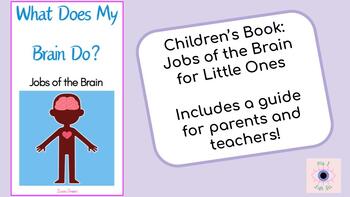What Does my Brain Do? Jobs of the Brain Children's Book
Ms I Life Sci
0 Followers
Resource Type
Standards
NGSS4-LS1-1
NGSS1-LS1-2
NGSS4-LS1-2
NGSSK-LS1-1
NGSSMS-LS1-8
Formats Included
- PDF
Pages
14 pages total
Ms I Life Sci
0 Followers
Description
This a children's book written for little ones. It is rhyming and covers the various jobs of our brain.
It includes a guide at the end for teachers and parents, which will help them to elaborate while reading each page. This allows the parent or teacher to adapt the content taught, depending on the age level.
Although this is written for young children, older children can benefit from it as well. I teach this material to my 7th grade biology students. We go into more depth after covering the book's topics.
Total Pages
14 pages total
Answer Key
N/A
Teaching Duration
30 minutes
Report this resource to TPT
Reported resources will be reviewed by our team. Report this resource to let us know if this resource violates TPT’s content guidelines.
Standards
to see state-specific standards (only available in the US).
NGSS4-LS1-1
Construct an argument that plants and animals have internal and external structures that function to support survival, growth, behavior, and reproduction. Examples of structures could include thorns, stems, roots, colored petals, heart, stomach, lung, brain, and skin. Assessment is limited to macroscopic structures within plant and animal systems.
NGSS1-LS1-2
Read texts and use media to determine patterns in behavior of parents and offspring that help offspring survive. Examples of patterns of behaviors could include the signals that offspring make (such as crying, cheeping, and other vocalizations) and the responses of the parents (such as feeding, comforting, and protecting the offspring).
NGSS4-LS1-2
Use a model to describe that animals receive different types of information through their senses, process the information in their brain, and respond to the information in different ways. Emphasis is on systems of information transfer. Assessment does not include the mechanisms by which the brain stores and recalls information or the mechanisms of how sensory receptors function.
NGSSK-LS1-1
Use observations to describe patterns of what plants and animals (including humans) need to survive. Examples of patterns could include that animals need to take in food but plants do not; the different kinds of food needed by different types of animals; the requirement of plants to have light; and, that all living things need water.
NGSSMS-LS1-8
Gather and synthesize information that sensory receptors respond to stimuli by sending messages to the brain for immediate behavior or storage as memories. Assessment does not include mechanisms for the transmission of this information.





